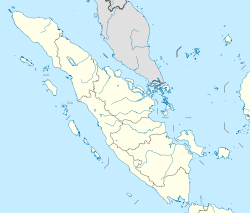Bukit Barisan Selatan National Park is a national park in Sumatra, Indonesia. The park located along the Bukit Barisan mountain range, has a total area of 3,568 km2, and spans three provinces: Lampung, Bengkulu, and South Sumatra. Together with Gunung Leuser and Kerinci Seblat national parks it forms a World Heritage Site, Tropical Rainforest Heritage of Sumatra.[1]
| Bukit Barisan Selatan National Park | |
|---|---|
| Taman Nasional Bukit Barisan Selatan | |
 Two belibis at Asam Lake on Lampung Province area | |
| Location | Sumatra, Indonesia |
| Coordinates | 5°26′S 104°20′E / 5.433°S 104.333°E |
| Area | 356,800 hectares (882,000 acres; 3,568 km2) |
| Established | 1982 |
| Governing body | Ministry of Environment and Forestry |
| World Heritage site | 2004 |
| Type | Natural |
| Criteria | vii, ix, x |
| Designated | 2004 (28th session) |
| Part of | Tropical Rainforest Heritage of Sumatra |
| Reference no. | 1167 |
| Region | Asia-Pacific |
| Endangered | 2011–present |
A signboard containing a welcome message to Bukit Barisan Selatan National Park a few kilometers away from the citi of Liwa, Indonesia West Lampung Regency, the secondary forest of Bukit Barisan National Park is designated by UNESCO as a world heritage.[2]
Flora and fauna
editThe national park stretching along the Bukit Barisan mountain range is in average only 45 km wide but 350 km long. The northern part is mountainous with its highest point at Gunung Pulung (1,964 m), while its southern section is a peninsula.[1] It is covered by montane forest, lowland tropical forest, coastal forest and mangrove forest.[3]
Plants in the park include Nipa palm, Casuarina equisetifolia, Anisoptera curtisii and Gonystylus bancanus, as well as species of Sonneratia, Pandanus, Anthoshorea, Shorea, and Dipterocarpus. Large flowers in the park include the Rafflesia arnoldii, Amorphophallus decus-silvae, Amorphophallus titanum and the world's largest orchid the Grammatophyllum speciosum.[3]
The park is home to many endangered and threatened species, including:
- Sumatran elephant (about 500 animals, or 25% of the total remaining population of this subspecies live in the park)
- Sumatran striped rabbit (most recent records of this poorly known species have been from the park)
- Sumatran rhinoceros (an estimated 17-24 Sumatran rhinos live in the park;[citation needed] approximately the same number live in Gunung Leuser National Park, along with approximately 30-35 in Way Kambas National Park, comprising a total population of fewer than 100 animals[citation needed]
- Sumatran tiger (approximately 40 adult tigers or 10% of the remaining Sumatran tigers live in the park).
Other animals in the park are the Malayan tapir, siamang, Sumatran surili, sun bear and lesser mouse-deer.[3] There are over 300 species of bird in the park, like the critically endangered Sumatran ground-cuckoo.[4]
Conservation and threats
editThe area was first protected by the Dutch East Indies government in 1935, that declared the South Sumatra I Nature Reserve.[5] The area became a national park in 1982.[6]
Since the 1970s there have been numerous squatters established within the park, and despite forced evictions in the early 1980s, their numbers increased since 1998. In 2006, it was estimated that the squatter encroachment by about 127,000 people covered an area of 55,000 ha. For the period between 1972 and 2006, it is estimated that 63,000 ha of primary forest cover has been lost.[5] This represents 20% of the forests lost to illegal agriculture. The World Wide Fund for Nature found that more than 450 km2 of park land is being used for growing coffee, and the organisation is now working with multinational coffee companies to help them avoid buying illegally grown coffee.[7]
In 2021 this situation is still pending.[8]
See also
editReferences
edit- ^ a b "Tropical Rainforest Heritage of Sumatra". UNESCO. Retrieved 2007-09-30.
- ^ "Travel Blog Indonesia".
- ^ a b c "Bukit Barisan Selatan National Park". Ministry of Forestry of Indonesia. Archived from the original on December 19, 2013. Retrieved 18 December 2013.
- ^ WWF: "Projects: Bukit Barisan Selatan", retrieved 18 December 2013
- ^ a b Levang, Patrice; Sitorus, Soaduon; Gaveau, David; Sunderland, Terry (2012). "Landless Farmers, Sly Opportunists, and Manipulated Voters: The Squatters of the Bukit Barisan Selatan National Park (Indonesia)". Conservation and Society. 10 (3): 243–255. doi:10.4103/0972-4923.101838. ISSN 0972-4923. JSTOR 26393081.
- ^ WWF Indonesia: "Bukit Barisan Selatan National Park" Archived 2020-02-12 at the Wayback Machine, Retrieved 18 December 2013.
- ^ Leow, Claire (January 19, 2007). "Nestlé to scrutinize Indonesia coffee amid wildlife-endangerment fears". International Herald Tribune. Archived from the original on January 22, 2007. Retrieved June 12, 2017.
{{cite news}}: CS1 maint: bot: original URL status unknown (link) - ^ How Your Cup of Coffee Is Clearing the Jungle It seemed like an easy crime to stop: protected Indonesian rainforest, cut for coffee farms. But a globalized economy can undermine even the best-laid plans.

